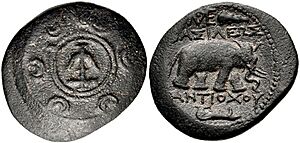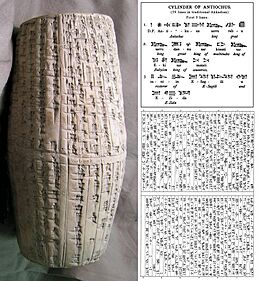Antiochus I Soter facts for kids
Quick facts for kids Antiochus I |
|
|---|---|
|
|

Silver tetradrachm of Antiochus I Soter, minted in Magnesia on Mt. Sipylus, featuring a portrait of Antiochus on the obverse. SC 318c
|
|
| Basileus of the Seleucid Empire | |
| Reign | September 281 – 2 June 261 BC |
| Predecessor | Seleucus I Nicator |
| Successor | Antiochus II Theos |
| Born | c. 324 BC Babylon, Macedon |
| Died | 2 June 261 BC (aged 61–63) |
| Spouse | Stratonice |
| Issue |
|
| Dynasty | Seleucid dynasty |
| Father | Seleucus I Nicator |
| Mother | Apama |
| Religion | Mesopotamian religion and Greek polytheism |
Antiochus I Soter (Greek: Ἀντίοχος Σωτήρ, Antíochos Sōtér; meaning "Antiochus the Savior"; born around 324 BC, died June 2, 261 BC) was a powerful king of the Seleucid Empire. This empire was one of the largest states that formed after the death of Alexander the Great. Antiochus became king in 281 BC, taking over from his father, Seleucus I Nicator. He ruled during a time when his empire faced many challenges. He managed to keep it mostly stable until his death. He was the last known ruler to be called the ancient Mesopotamian title of King of the Universe.
Contents
Life of Antiochus I
Antiochus's father was Seleucus I Nicator, a famous general of Alexander the Great. His mother was Apama, whose father was Spitamenes. Apama was one of the princesses Alexander the Great arranged for his generals to marry. The Seleucid family later claimed that Apama was the daughter of Darius III. This was to make their rule seem more legitimate. It connected them to both the Achaemenid Persian Empire and Alexander's legacy.
Family and Succession
In 294 BC, before his father passed away, Antiochus married Stratonice. She had previously been married to his father. Ancient stories say his father arranged this marriage. Antiochus and Stratonice had five children together:
- Seleucus
- Laodice
- Apama II
- Stratonice II
- Antiochus II Theos, who became king after his father.
Early Challenges as King
When his father was killed in 281 BC, Antiochus faced a huge task. He had to keep his vast empire from falling apart. A revolt started in Syria almost right away. Antiochus had to make peace with Ptolemy Keraunos, the person who killed his father. This meant giving up control of Macedonia and Thrace. In Anatolia, he struggled to control areas like Bithynia and the Persian kingdoms in Cappadocia.
Victory Over the Gauls
In 278 BC, a group of people called the Gauls invaded Anatolia. Antiochus won a big victory against them in 275 BC. He used Indian war elephants in this battle. This important win is why he earned the title Soter, which means "savior" in Greek.
First Syrian War
Towards the end of 275 BC, a conflict began over the region of Coele-Syria. This area had been disputed between the Seleucid Empire and the Ptolemaic Kingdom of Egypt since 301 BC. The Ptolemies had controlled it, but the Seleucids still claimed it. This conflict, known as the First Syrian War, did not change the borders much. However, some cities like Damascus and coastal areas in Asia Minor changed hands.
In 268 BC, Antiochus I began building the Ezida Temple in Borsippa. His oldest son, Seleucus, had been ruling the eastern parts of the empire. However, Antiochus removed his son from power around 268/267 BC after he was accused of rebellion. Around 262 BC, Antiochus tried to stop the growing power of Pergamum. But he was defeated near Sardis and died soon after. His second son, Antiochus II Theos, became king in 261 BC.
City of Ai-Khanoum
Recent studies suggest that the Greek city of Ai-Khanoum was founded around 280 BC by Antiochus I. This city is located in northern Afghanistan. It is at the meeting point of the Panj River and the Kokcha River. It was also very close to the Indian subcontinent.
Connections with India
Antiochus I had friendly relationships with Bindusara, the ruler of the Maurya Empire in India. A Greek ambassador named Deimachos of Plateia represented Antiochus at Bindusara's court. A Greek writer from the 3rd century, Athenaeus, tells a story about Bindusara. He asked Antiochus to send him sweet wine, dried figs, and a sophist (a wise teacher). Antiochus replied that he would send the wine and figs. But he explained that Greek laws did not allow him to sell a sophist.

Antiochus is likely the Greek king mentioned in the Edicts of Ashoka. These are messages from the Indian Emperor Ashoka. Ashoka was spreading Buddhist ideas. One edict says:
And even this conquest [preaching Buddhism] has been won by the Beloved of the Gods here and in all the borderlands, as far as six hundred yojanas (a very long distance) away, where Antiochus, king of the Yavanas [Greeks] rules, and beyond this Antiochus four kings named Ptolemy, Antigonos, Magas and Alexander rule.
Ashoka also said that he encouraged the growth of herbal medicine for people and animals. He said this was done in the lands of the Greek kings:
Everywhere within Beloved-of-the-Gods, King Piyadasi's [Ashoka's] domain, and among the people beyond the borders, the Cholas, the Pandyas, the Satiyaputras, the Keralaputras, as far as Tamraparni and where the Greek king Antiochus rules, and among the kings who are neighbors of Antiochos, everywhere has Beloved-of-the-Gods, King Piyadasi, made provision for two types of medical treatment: medical treatment for humans and medical treatment for animals. Wherever medical herbs suitable for humans or animals are not available, I have had them imported and grown. Wherever medical roots or fruits are not available I have had them imported and grown. Along roads I have had wells dug and trees planted for the benefit of humans and animals.
It is also possible that the Greek king mentioned in Ashoka's edicts was Antiochus's son and successor, Antiochus II Theos. However, Antiochus I's close ties with the East make him a strong candidate.
Artistic Depictions
The relationship between Antiochus and Stratonice has been a popular subject in Neoclassical art. Many famous paintings show them.
Images for kids
-
Antiochus and Stratonica (1774) by Jacques-Louis David.
-
Antiochus and Stratonice by Jean-Auguste-Dominique Ingres.
See Also





